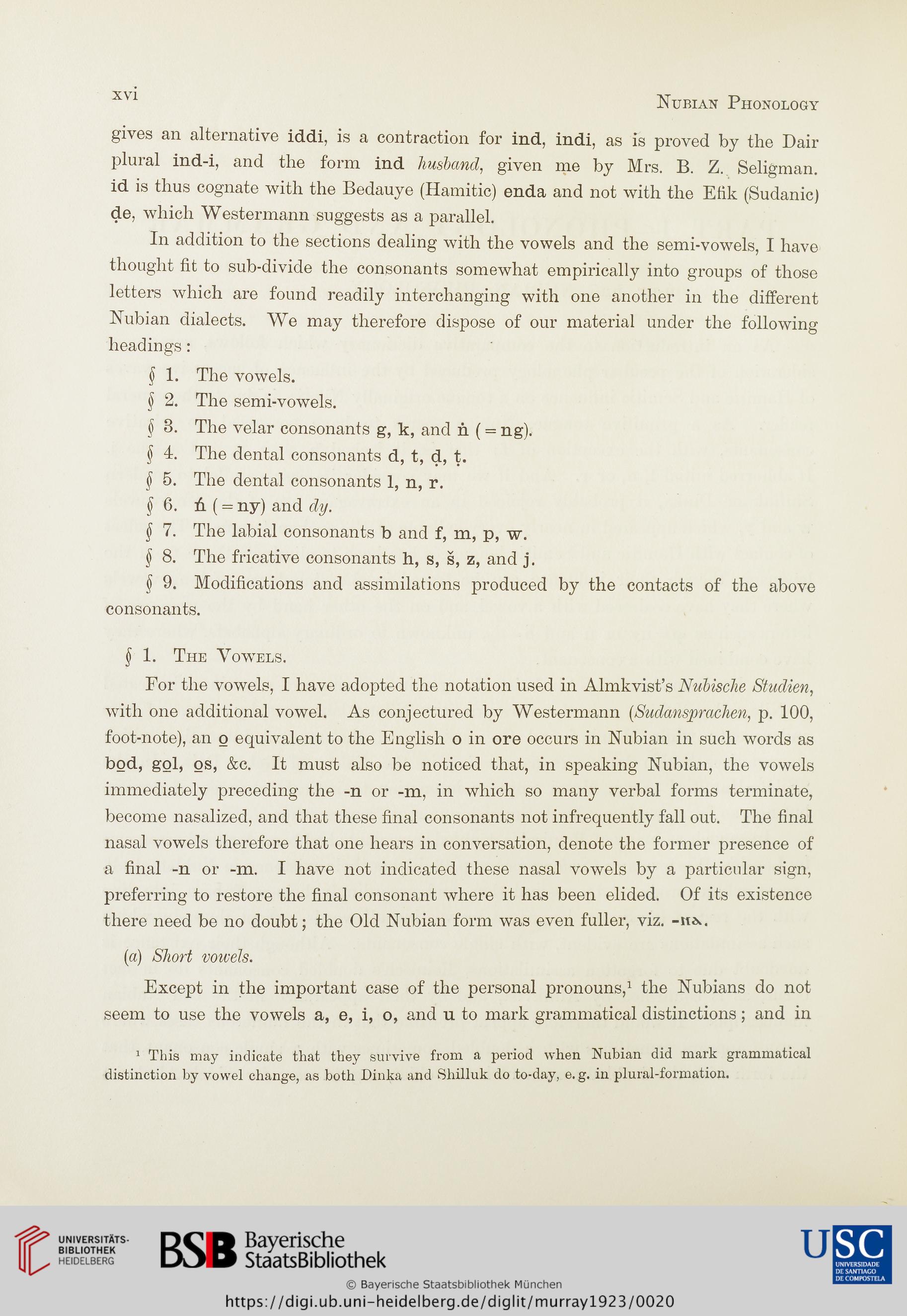xvi
Nubian Phonology
gives an alternative iddi, is a contraction for ind, indi, as is proved by the Dair
plural ind-i, and the form ind husband, given me by Mrs. B. Z. Seligman,
id is thus cognate with the Bedauye (Hamitic) enda and not with the Elik (Sudanic)
de, which Westermann suggests as a parallel.
In addition to the sections dealing with the vowels and the semi-vowels, I have
thought fit to sub-divide the consonants somewhat empirically into groups of those
letters which are found readily interchanging with one another in the different
Nubian dialects. We may therefore dispose of our material under the following
headings:
$ 1. The vowels.
J 2. The semi-vowels.
J 3. The velar consonants g, k, and h (= ng).
$ 4. The dental consonants d, t, d, t.
J 5. The dental consonants 1, n, r.
§ 6. ii (= ny) and dy.
§ 7. The labial consonants b and f, m, p, w.
J 8. The fricative consonants h, s, s, z, and j.
J 9. Modifications and assimilations produced by the contacts of the above
consonants.
§ 1. The Vowels.
For the vowels, I have adopted the notation used in Almkvist’s Nubische Studien,
with one additional vowel. As conjectured by Westermann (Sudansprachen, p. 100,
foot-note), an o equivalent to the English o in ore occurs in Nubian in such words as
bod, gol, os, &c. It must also be noticed that, in speaking Nubian, the vowels
immediately preceding the -n or -m, in which so many verbal forms terminate,
become nasalized, and that these final consonants not infrequently fall out. The final
nasal vowels therefore that one hears in conversation, denote the former presence of
a final -n or -m. I have not indicated these nasal vowels by a particular sign,
preferring to restore the final consonant where it has been elided. Of its existence
there need be no doubt; the Old Nubian form was even fuller, viz. -h&.
(a) Short vowels.
Except in the important case of the personal pronouns,1 the Nubians do not
seem to use the vowels a, e, i, o, and u to mark grammatical distinctions; and in
1 This may indicate that they survive from a period when Nubian did mark grammatical
distinction by vowel change, as both Dinka and Shilluk do to-day, e. g. in plural-formation.
Nubian Phonology
gives an alternative iddi, is a contraction for ind, indi, as is proved by the Dair
plural ind-i, and the form ind husband, given me by Mrs. B. Z. Seligman,
id is thus cognate with the Bedauye (Hamitic) enda and not with the Elik (Sudanic)
de, which Westermann suggests as a parallel.
In addition to the sections dealing with the vowels and the semi-vowels, I have
thought fit to sub-divide the consonants somewhat empirically into groups of those
letters which are found readily interchanging with one another in the different
Nubian dialects. We may therefore dispose of our material under the following
headings:
$ 1. The vowels.
J 2. The semi-vowels.
J 3. The velar consonants g, k, and h (= ng).
$ 4. The dental consonants d, t, d, t.
J 5. The dental consonants 1, n, r.
§ 6. ii (= ny) and dy.
§ 7. The labial consonants b and f, m, p, w.
J 8. The fricative consonants h, s, s, z, and j.
J 9. Modifications and assimilations produced by the contacts of the above
consonants.
§ 1. The Vowels.
For the vowels, I have adopted the notation used in Almkvist’s Nubische Studien,
with one additional vowel. As conjectured by Westermann (Sudansprachen, p. 100,
foot-note), an o equivalent to the English o in ore occurs in Nubian in such words as
bod, gol, os, &c. It must also be noticed that, in speaking Nubian, the vowels
immediately preceding the -n or -m, in which so many verbal forms terminate,
become nasalized, and that these final consonants not infrequently fall out. The final
nasal vowels therefore that one hears in conversation, denote the former presence of
a final -n or -m. I have not indicated these nasal vowels by a particular sign,
preferring to restore the final consonant where it has been elided. Of its existence
there need be no doubt; the Old Nubian form was even fuller, viz. -h&.
(a) Short vowels.
Except in the important case of the personal pronouns,1 the Nubians do not
seem to use the vowels a, e, i, o, and u to mark grammatical distinctions; and in
1 This may indicate that they survive from a period when Nubian did mark grammatical
distinction by vowel change, as both Dinka and Shilluk do to-day, e. g. in plural-formation.




